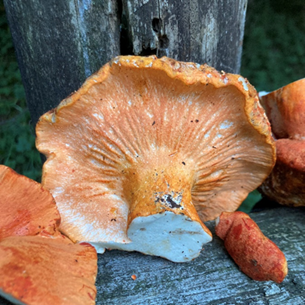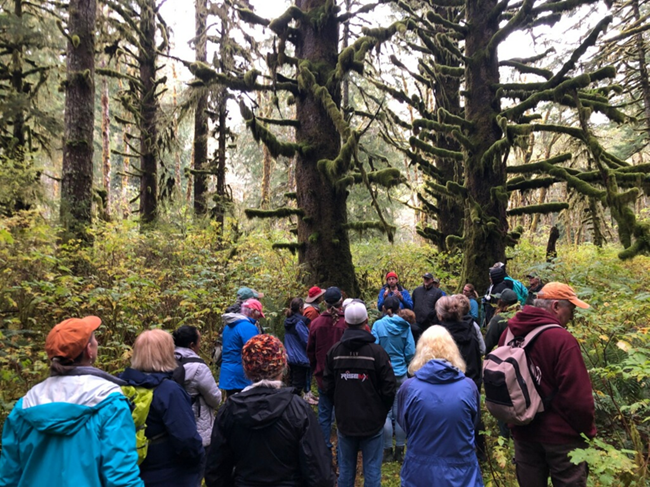Foraging for mushrooms is a great way to stay active once the rainy season returns to the Coast. On the morning of October 27th, Tillamook County residents gathered on Mt. Hebo to learn about foraging wild mushrooms while getting a bit of exercise. The walk was put on by Tillamook County Wellness (TCW) and led by AmeriCorps Vista Brett Buesnel. As a member of the TCW team and experienced forager, Brett led the eager crew on a relatively short walk packed with many mushroom foraging and identification tips. The information shared ranged from impromptu observations like, “sometimes they’re hairy, this one for example reminds me of Chewbacca”, to practical cleaning methods like gently spraying down particularly dirty Lobster Mushrooms with a garden hose. When conditions are right, the fungi on Mt. Hebo, often out of sight, underground and hidden in rotting logs will create fruiting bodies called sporocarps, more commonly known as mushrooms. These uniquely formed and functionally varied structures share one goal – to spread their spores in bid to reproduce.

(Hypomyces lactifluorum)
A particular mushroom was on the minds of many walkers that day: the Lobster mushroom (Hypomyces lactifluorum). This mushroom is actually a parasitic fungus that grows on the unassuming Russula brevipes and changes the white host mushroom into a wrinkled bright-orange form, giving it the color of a cooked Lobster, that also happens to taste great on pizza. The conditions on Mt. Hebo were just right to find fresh Lobster Mushrooms earlier in the month. For the walkers on the mountain that day, all the lobsters found proved to be on the soggy side. Changing conditions can cut a season in a particular area short, or possibly extend it later into the year than what is typical. The Lobster mushrooms that were found provided a great opportunity to share the important lesson of what a mushroom looks like when it is no longer fit for consumption.
Here are some signs of when to leave a Lobster mushroom in the woods and off your plate:
- It’s color has changed from bright orange to dark red
- Soft areas are a sign of decay which relative to a fresh mushroom will appear more translucent than solid white when cut
- Small holes in the mushroom’s flesh are an indicator of bugs having lunch
- Despite a name that recalls the sea, it’s not a good sign if it smells strongly of fish
Even with the cold temperatures and increasingly strong drizzle, spirits of the group remained high. Back at the trailhead, attendees received a zine produced for the event with information on how to identify a chanterelle, important terms in mushroom identification and a healthy wild mushroom recipe. With empty baskets and full minds, the walk came to an end and folks returned to their vehicles and dispersed like so many spores until the next foray.
If this sounds like your kind of fun and are interested in learning the basics of mushroom identification, Tillamook County Wellness will be hosting a Zoom event on November 17th from 6:00 PM to 8:00 PM. Brett Buesnel will again be serving as presenter and share the process of how to identify a mushroom and additional resources you can use to further your skills. Please register using this link or by contacting Brett at bbuesnel@co.tillamook.or.us.
AUTHOR: Brett Buesnel, AmeriCorps VISTA at Tillamook County Community Health Center
For more local health and wellness information, follow Tillamook County Wellness on Facebook, Instagram and Twitter.

